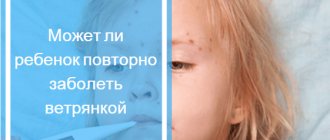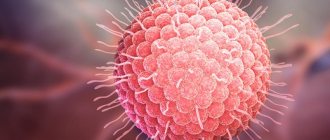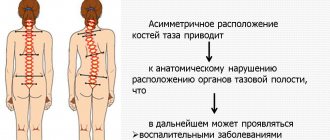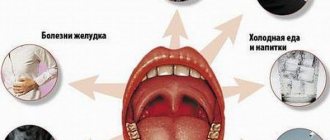Types of chickenpox and its symptoms in adults
The symptoms of chickenpox in adults are very similar to those observed in children. Treatment of chickenpox in adults follows the same principles and methods, depending on the form of chickenpox.
Below we have depicted a table with possible forms of chickenpox and photos:
Table: Forms of chickenpox
There are four common types of chickenpox: Hemorrhagic form
. This form of chickenpox is characterized by the appearance of hemorrhagic exudate (bleeding) in the blisters. During the period of complications of chickenpox, bleeding may be observed: nasal, renal and gastrointestinal.
Bullous form
. During this form of chickenpox, thin-walled blisters are observed, which open and form weeping, poorly healing surfaces.
Gangrenous form
. This form of chickenpox is characterized by the fact that a black crust forms under the blisters, under which an ulcer with a purulent bottom forms. Ignoring this form of manifestation can lead to intoxication of the body and even death.
Visceral form
. In this form, internal organs are affected. Over time, they stop functioning normally, which also leads to death.
Below, we have depicted in the photo what chickenpox looks like in adults:
Photo: Chickenpox in adults
Chickenpox symptoms in adults
Adults infected with chickenpox usually have the same symptoms as children, although the symptoms tend to be more severe. Signs of chickenpox in adults are:
Red spots
. The most recognizable sign of chickenpox is the itchy, fluid-filled red spots that appear all over the body. These red spots can form skin scabs. While old spots heal, new spots may still appear.
Flu symptoms
. Feeling unwell and having a fever are also common symptoms. In addition to generally feeling unwell, you may also experience loss of appetite, fatigue, body aches and headaches.
The incubation period for chickenpox can last 7-21 days. A person remains infectious for 5-7 days. 1-2 days before the rash appears, a person is contagious to those who have not previously been infected with chickenpox or have not been vaccinated. It is recommended to limit meetings with people who have not had chickenpox until all the red spots have dried and scabs have formed. With severe chickenpox, a person experiences severe intoxication. The patient experiences weakness, drowsiness, muscle, headache and joint pain, accompanied by high temperature (up to 40° C). The nervous system is affected; Visual disturbances, loss of sensation and seizures may occur. Complications with purulent bacterial infections of internal organs may also develop.
Although the symptoms of chickenpox in children and adults are quite similar, each generation experiences the disease differently. It is much more difficult for an adult to endure complications in the body than for children. In order to avoid serious consequences from chickenpox in adults, effective treatment is offered.
What is chicken pox
Chickenpox is an infectious disease characterized by high contagiousness. Chickenpox is caused by a virus called Varicella zoster. It belongs to the group of microorganisms that cause herpes, is spread by airborne droplets and can easily travel several meters. Due to its microscopic size, the virus easily travels with air currents from one room to another. It can penetrate into apartments even through ventilation ducts.
It is for the volatility and “frivolity” of the virus that the disease got its name.
The disease manifests itself in the form of specific rashes on the skin and mucous membranes. General intoxication of the body is characteristic. The peak activity of the virus occurs in the autumn-winter season. At risk are adults who work with children: kindergarten teachers and nannies, teachers, doctors.
You only get chickenpox once in your life. Having had it in childhood, a person acquires a strong immunity to this disease. However, in medical practice there were still isolated cases of recurrent disease. Secondary chickenpox occurs in a very mild form, there are few elements of the rash, and they practically do not bother the patient. Therefore, if a person gets sick again, he may never know that he has chickenpox. However, he poses a potential threat to others.
The Varicella zoster virus remains “dormant” in the body of the person who has been ill, and someday. under the influence of provoking factors, it can become more active, causing its already adult carrier suffering in the form of an extremely unpleasant phenomenon - shingles. The latter is characterized by an unbearable burning sensation and is not limited to one case of the disease in a lifetime, but can appear several times.
What is shingles, how dangerous it is, is it contagious, symptoms of the disease and its treatment:
Varicella zoster virus affects only humans, mainly children
How does the initial stage manifest itself and how does the disease develop?
The first rash in adults with chickenpox appears as a spotty rash and may be accompanied by short-term redness of the skin. The affected areas may progress to papules, which become itchy over time. After a couple of days, such papules turn into pustules and then become crusty.
The rashes initially appear on the body in the form of clusters, then they can spread throughout the body. New papules appear even when old papules have already begun to crust over. The rash can be quite localized, but in more common cases it affects the upper part of the body.
Ulcerative papules can also be found on mucous membranes, including the mouth and genitals. Ulcers in the mucous membranes very often lead to discomfort when swallowing or chewing food.
The appearance of new rashes usually stops by the 5th day, the vesicles become crusted by the 6th day; approximately 20 days after the onset of the disease they disappear.
Scheme: Course of chickenpox in adults: symptoms, frequency and development of papules
Characteristics of the rash
Chickenpox in infants
The rash develops as follows:
- a few hours after the appearance of the ulcers fill with fluid. The appearance of blisters on the body results in very severe itching. Moms and dads are obliged to monitor their baby so that he does not scratch these sores, otherwise he will contract an infectious disease and only get worse;
- After a couple of days, the sores dry out and a burgundy-colored crust appears on them. Attacks of new rashes come in waves - some viral spots pass, others appear. This continues for a period of time from 4 to 8 days;
- After 2 weeks, the rash decreases and the crusts disappear on their own. Under no circumstances should you rip them off, because scars may remain for life. If the child does not rip them off, then only pink spots will remain, which disappear over time. Usually such rashes last for 10-11 days.
How long does chickenpox last in adults?
The older the child, the more difficult his chickenpox is, and the same applies to an adult.
It can take about seven days from the moment you are infected with chickenpox to the first symptoms. Chickenpox can begin with a high fever (39-40 degrees), which can last up to several days. An increase in temperature is associated with the characteristics of the immune response to the virus in adults.
At the first stage, the sick adult experiences weakness, aches and pain in the joints, headaches and nausea. These signs indicate general intoxication of the body.
If the patient feels signs of severe weakness and may even lose consciousness, it is necessary to call an ambulance because with such a course of the disease, the patient can be observed in a hospital.
It is not recommended to lower the temperature with aspirin or analgin; they can lead to complications from the liver.
Following the temperature, papules appear: on the body and face. The peculiarity of the rash in adults is that it is more profuse and can be complicated by a bacterial infection.
Chickenpox rash lasts longer in adults than in children. Papules can develop over a period of 9 days and leave behind pockmarks (small indentations in the skin) even if the rash is not scratched.
Below, we have written in detail recommendations and treatment options for chickenpox in adults. As you understand, due to the fact that the development of infection in adults lasts longer, the treatment time for chickenpox in adults will also be longer. During the period of contagiousness, it is recommended to go into voluntary quarantine so as not to endanger other adults with chickenpox.
Symptoms of incipient chickenpox
During the incubation period, a person lives a standard life. The most difficult time for the development of the disease is the prodromal stage.
The first symptoms of illness are high temperature, rising to 38 degrees. General intoxication is observed: nausea, vomiting, weakness, dizziness, migraine. The lymph nodes swell painfully.
The fever lasts for 3-5 days, and at the peak of acne it rises to critical levels. Single redness or protruding bumps appear. The process is accompanied by incessant itching.
When the rash begins, you need to carefully monitor the number of vesicles, constantly lubricating them with ointment or anti-scratching gel. First a spot appears, and then a bubble with a watery liquid appears. The top of the pimple is pressed in the center. You cannot rip them off - there is a high probability of aggravating complications.
Dropsy initially appears on tender areas - on the abdomen, thighs, genitals, groin and face. Then redness appears on the scalp, in the mouth (tongue, larynx, inner surface of the cheeks, throat).
The rash may take on the appearance of scarlet fever or measles. The frequency and number of days of intense redness indicates the severity of chickenpox:
Redness of individual areas of the skin for 2-3 days, the fever subsides already on the 3rd day, without worsening - a mild form.
The blisters are accompanied by an increase in body temperature along with papules that appear in waves, lasting 4-5 days, then it declines - the average degree.
The appearance of vesicles occurs over 10 days - either decreasing or increasing in number again, the temperature rises to critical levels (above 400), an additional respiratory tract infection is added - a severe phase.
Bubbles have a different character. Sometimes they are no more than 5 mm in diameter, but there are a huge number of them. Conversely, the number of bubbles is small, but their circumference reaches 1-1.5 cm diagonally.
Features of the course of chickenpox in adults
The rash associated with chickenpox is often recognizable, especially by trained healthcare professionals. But since people do not often go to the doctor with suspicion of chickenpox, we recommend paying attention to the following symptoms:
- Heat;
- Headache;
- Fatigue;
- Loss of appetite.
In adolescents and adults, chickenpox almost always occurs in a complicated form.
Even if chickenpox is treated at an early stage, complications can be avoided. During the period of chickenpox, an adult may feel weakness, aching joints and muscle pain. At the same time, a person may experience headaches, nausea and other signs of general intoxication of the body. Below, we will look at the treatment of itching with chickenpox in adults.
The most common complications after chickenpox in adults
For those adults who did not get chickenpox as children or were not vaccinated, an attack of chickenpox can lead to serious, sometimes fatal complications.
Table: Possible complications after chickenpox in adults
Adults who experience chickenpox with complications are at risk of pneumonia and, less commonly, meningitis or encephalitis (a brain infection). Serious complications from chickenpox include:
- Bacterial infections of the skin and soft tissues in children, including group A streptococcal infections;
- Lung infection (pneumonia);
- Infection or inflammation of the brain (encephalitis and cerebellar ataxia);
- Bleeding problems (hemorrhagic complications);
- Blood infections (sepsis);
- Dehydration.
Some people with serious complications from chickenpox may become so sick that they need to be hospitalized. Chickenpox can also cause death. To avoid complications from chickenpox, it is necessary to apply appropriate treatment.
Treatment of chickenpox in adults
There is no universal cure for chickenpox. Preparations and remedies are mainly used to combat the external manifestations of the disease: rash, skin inflammation and fever.
The system of taking medications depends on the severity of the disease.
During the incubation period, a person may not even be aware of the need for treatment, but after symptoms appear, methods are used to eliminate itching, pain, and fever. During this period, a person needs to isolate himself (go into so-called quarantine) in order to prevent infection of other people. Treatment of chickenpox occurs through the elimination of the symptoms of the disease. The main means of treatment are:
- Antiseptics;
- Immunostimulants;
- Antihistamines;
- Antiviral agents;
- Antibiotics.
Quick treatment of chickenpox in adults occurs with mild or moderate illness. In this block we will look at what drugs are used to treat chickenpox in adults and how chickenpox can be treated in men and women with complications. The table shows the treatment regimen for chickenpox in adults:
Photo: Treatment of chickenpox in an adult
Treatment of chickenpox in adults with antiviral drugs
Treating chickenpox with antiviral tablets in the first 24 hours after the rash appears reduces the duration and severity of symptoms. If the disease is mild without complications, antiviral treatment is not recommended. Chickenpox in adults is often treated with tablets.
If there is a risk of developing a severe infection (especially for people with eczema) or chronic lung diseases, Valaciclovir, Famciclovir or Acyclovir are prescribed.
Standard dose:
Pharmaciclovir - 500 mg / 3 times a day; Valacyclovir - 1 g / 3 times a day; Acyclovir - up to 800 mg / 4-5 times a day.
For immunocompromised adults, acyclovir 10 to 12 mg/kg IV every 8 hours should be prescribed.
In some cases, antibiotics are prescribed. Treatment of chickenpox with antibiotics is not necessary; they are rarely prescribed for chickenpox. They are often prescribed when there is a bacterial infection. In other cases, the drugs are useless.
Treatment of chickenpox in adults: what to apply?
In order to prevent infection in open sores, you need to know what to apply to the skin to alleviate its condition. Dermatologists recommend using modern antiseptics, which can easily help disinfect the skin and speed up wound healing.
It is necessary to smear the skin with antiseptics frequently (according to the standard for the treatment of chickenpox - every 1-2 hours). This way you can speed up your quick recovery. We wrote in detail about effective antiseptics and creams in a previous article on the treatment of chickenpox in both adults and children. In most cases, after suffering from the disease, a person develops antibodies to chickenpox, which protect him from re-infection. However, this is not always the case. Re-infection is quite possible.
Chickenpox and pregnancy
There is no human body more vulnerable to chickenpox than a developing baby in the womb. At certain stages of pregnancy, infection with herpes poses a danger to the fetus. Therefore, all girls should think about preventing chickenpox at the stage of planning to replenish their family. Why only in advance? Since this infection is very difficult to control once the moment of introduction of microorganisms into living tissues has come.
If the expectant mother did not have chickenpox in childhood, then especially dangerous periods for the child during infection will be:
- beginning of the first trimester – the probability of infection is 0.4%;
- from the 14th to the 20th week - a particularly high risk of fetal damage (2%);
- three days before birth – infection occurs in 10-20% of cases;
- five days after the birth of a child – the occurrence of congenital chickenpox (25-30%).
It is very difficult to accurately determine the moment of infection, since the first signs of chickenpox appear only at the beginning of the acute stage of infection. The diagnosis of congenital herpes zoster disease is made at the first symptoms in a newborn that occur before the 11th day of life. To prevent damage to the baby during childbirth, doctors help extend the gestational age by several days. During this time, the woman develops her own antibodies, which will prevent the further spread of herpes agents.
Every woman should know that while pregnant, it is impossible to protect against these viruses. Immunization by vaccination, as well as taking many medications during this period, is simply prohibited due to the risk of developing fetal pathologies and other side effects.
Chickenpox in adults for the second time: treatment
Treatment of chickenpox in adulthood, especially if a person gets sick for the second time, is a rather unpleasant thing. Treatment for chickenpox in adults has its own challenges. If you come into direct contact with someone who has chickenpox and you have not received the chickenpox vaccine or have not had the disease itself, there is a good chance you will become infected. In principle, even if you were ill as a child and have a weak immune system, you can get sick again. What is the reason for this? There are several reasons:
- If you had chickenpox in infancy or were younger than 6 months;
- If you have had a mild or subclinical chickenpox infection for the first time;
- If your immune system has failed.
Chickenpox in adults the second time appears in the same way as the first time. When treating chickenpox in adults, the same drugs and doses are prescribed as when treating chickenpox for the first time (unless, of course, complications arise).
If chickenpox occurs again, the doctor prescribes antibiotics and 3rd generation cephalosporins.
It should be noted that if you get chickenpox again or when recovering from it, you should stop tanning. It is best to hide chickenpox-affected areas of the body until they are completely healed, otherwise hyperpigmented scars may develop that will be difficult to get rid of.
If for the second time you have a pustular form, then you need to avoid water treatments until the pimples begin to dry out.
Treatment of chickenpox in adults at home
Chickenpox can be stopped not only with medications, but also with traditional methods of treating chickenpox in adults, which are usually used to relieve the symptoms of chickenpox:
Table: Treatment of chickenpox in adults at home
Oatmeal Baths: Soaking in a warm oatmeal bath can relieve dry and itchy skin. The best type of oats for this is colloidal oatmeal, which is oats ground into a fine powder so that it can be absorbed more easily into the skin.
Stay hydrated: Chickenpox can cause a fever, which can lead to dehydration. Drinking fluids throughout the day prevents dehydration, which can make you feel worse.
Do not scratch the vesicles: this is dangerous because it can lead to infection of the papules and leave permanent scars. One common way to prevent this is to wear mittens while sleeping (to avoid causing infection while scratching). Baking soda: Treatment of chickenpox rash in adults is done with light baking soda baths. Baking soda helps cleanse the skin and prevent bacteria from spreading. Chamomile baths: Chamomile infusion helps soothe the skin and cleanse it of excess bacteria. To prepare the remedy, you need to boil 50 g of flowers in 1 liter of water and leave to infuse for about an hour. Take baths with chamomile 1-2 times a day. When treating chickenpox in adults, it is recommended to follow a diet, that is, avoid certain foods during the illness:
- sour fruits and citrus fruits that irritate the oral mucosa;
- meat broths, which increase the secretion of gastric juice;
- hot seasonings, vinegar marinades and smoked foods, which can also irritate the skin;
- fatty fish, meat and fried foods, they are difficult to digest and increase the level of toxins;
- garlic, onions, radishes and radishes, which also irritate the skin;
- sweets (cakes, pastries, candies, ice cream, sweet carbonated water);
- rich foods that can create favorable conditions for another bacterial infection;
- teas, coffee, alcoholic beverages, which aggravate the course of the disease;
- products with a high content of allergens (eggs, strawberries, nuts, orange and red fruits and vegetables);
In general, you should avoid foods that cause bloating or other intestinal problems. We recommend watching a video about the treatment of chickenpox in adults, in which a pediatrician talks about how chickenpox occurs in adults and what drug treatment is usually used for chickenpox smallpox:
Video: Treatment of chickenpox in adults
Folk remedies
Folk remedies against the virus
There are a lot of folk methods to prevent chickenpox treatment at home, which can cause many problems, from becoming an annoying disease. Treatment in adults can also be supplemented with these drugs to remove unpleasant and painful effects. Here are some methods:
- to relieve itching, simply take a bath with baking soda or starch ;
- To heal smallpox, you can use a decoction of herbs : celandine, chamomile and calendula flowers (three tablespoons each). Boil these herbs in a liter of water for about 10 minutes and then take a bath with this decoction. It is advisable to do this a couple of times a day. It is important not to touch the crusts after this;
- to get rid of pink spots, you need to lubricate them with sunflower oil;
- a weakened immune system will be boosted by a mixture of lemon juice and honey . This remedy should be consumed about three times a day, 1 teaspoon. Or replace it with strawberry juice;
- You can infuse lemon balm, basil and chamomile flowers and drink 3-4 times a day. To do this, mix 10 grams of herbs and 200 milliliters of boiled water, you need to leave for about 30 minutes. You need to drink this decoction a couple of times a day, half a glass;
- Another extremely effective remedy: chopped parsley . You need to pour a couple of tablespoons of this spicy herb into 0.5 liters of boiling water. It is advisable to do all this in a jar and then wrap it in cloth. Leave and strain. You should take 1 teaspoon about 3 times a day;
- not inferior to other means - mumiyo . A very effective method that relieves itching, increases immunity, and after its use, wounds heal twice as fast. You can take it internally or apply it externally. To use it internally, you need to dilute a little mumiyo in 100 milliliters of lukewarm water. Drink half a glass once a day before meals on an empty stomach in the morning throughout the illness and for about 10 more days after the external manifestations of the disease have completely disappeared. For external action, dilute a little mumiyo in 40 milliliters of warm water. This solution should be applied to the rash a couple of times a day.
Prevention of chickenpox in adults
There are a number of home remedies and methods that are commonly used to relieve the symptoms of chickenpox, we wrote about them in detail in the previous block. Many people wonder whether it is possible to bathe with chickenpox?
Whether or not to wash with chickenpox depends on the patient’s well-being. In general, bathing for chickenpox is beneficial because it helps reduce the risk of secondary infection and promotes faster healing. It is not recommended to take water procedures at high temperatures.
Medical experts recommend avoiding cosmetics, washcloths and towels, as they can injure the skin.
Overall, take care of your health.
. At high temperatures, it is recommended to use cranberry juice, infusion of viburnum, rose hips or sea buckthorn. They are believed to help provide nutrients to the body and provide antimicrobial effects.
Some medical experts claim that blueberries contain active substances that can inhibit chickenpox pathogens due to their antiviral effect.
Celery juice also helps reduce intoxication and strengthen the immune system. Celery increases appetite, helps improve metabolism and increase hemoglobin. All you need is a little patience and strengthening your immunity.
Share with friends
Rate this article
Drug treatment
Due to the high risk of complications, it is advisable for adult patients to use medications. In addition, patients are simply required to remain in bed and take vitamins to strengthen the immune system.
Drug treatment includes:
- Antipyretic drugs (if necessary);
- Antihistamines (used to reduce itching);
- Use of sorbent drugs;
- Treating the rash with brilliant green;
- If necessary, mucous membranes are also disinfected;
- Use of antiviral drugs;
- Immunostimulating drugs.
Most patients are treated at home with the help of medical advice. But, without exception, the following rules apply to everyone:
- Do not comb or rub sores;
- Reduce the number of water procedures;
- Balance your diet. Eat foods rich in vitamins;
- Trim your nails and keep your hands clean.
Treatment at home
Diamond green
Treatment of chickenpox at home comes down to treating the skin in order to dry out the rash. The most common drugs with a drying effect are:
- Diamond Green;
- Potassium permanganate;
- Salicylic acid.
In addition to treating the skin, bedding should be changed and washed at high temperatures daily. Also, wet cleaning, ventilation and heat treatment of bedding is mandatory. It is extremely important to refrain from scratching the rash. Otherwise, scars may appear and there is also a high risk of infection. In this case, you cannot do without antibiotics.











